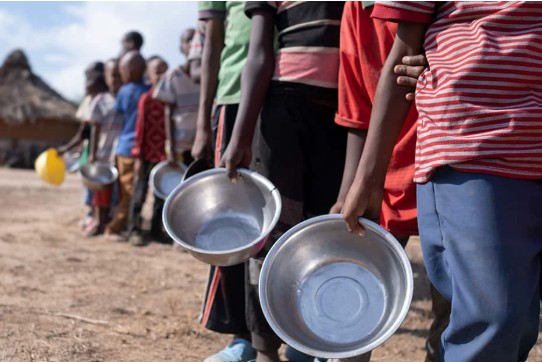Barriers to Food Security in Africa

Today we’re tackling a question that hits every African table: Can Africa feed itself? Spoiler alert: we can. So why are we spending $50 billion a year importing food, with that bill set to hit $110 billion by 2025? And who’s holding us back? Buckle up, because we’re diving deep into the numbers, the barriers, and yes, the role of globalists in keeping Africa hungry.
First, let’s talk potential. Africa is sitting on a goldmine—60% of the world’s uncultivated arable land. That’s right, 60%! Agriculture is already 35% of our GDP, employing more Africans than any other sector. Our agricultural market is worth $280 billion today, and with the right moves, it could hit $1 trillion by 2030. Look at Ethiopia: they expanded wheat production from 50,000 hectares in 2018 to 650,000 by 2022, wiping out wheat imports and exporting to Kenya and Djibouti. That’s the Africa we all want—a continent that feeds itself and the world! But here’s the reality check. Despite this potential, one in five Africans goes to bed hungry. 140 million of us face acute food insecurity. Why? It’s systemic barriers, some homegrown, some imposed from outside.
Barriers to Food Security in Africa
Number one: underinvestment. In 2003, African governments signed the Comprehensive Africa Agriculture Development Programme agreement, promising 10% of their budgets to agriculture. In 2021, the average was a measly 4.1%. Senegal’s excelling at 11%, and their sector’s thriving, but most countries are falling short. Number two: a financing gap. Africa needs $27 to $65 billion a year to transform agriculture, but banks lend just 3% of their portfolios to farming, even though it’s 29% of our GDP. High interest rates—often over 20%—and demands for collateral worth five times the loan lock out smallholder farmers, who produce 80% of our food. Mila Aziablé, Togo’s Minister of Water and Sanitation.
Then there’s the supply chain mess. Poor roads, outdated ports, and bad storage mean they lose 30% of our food imports before they even reach the market. Mechanization? Only 4-5% of our farms use modern equipment, compared to 95% in the US. Irrigation? Just 6% of our arable land, versus 70% in Asia. Add weather shocks—droughts, floods—and external disruptions like the Russia-Ukraine war, which cut 30 million metric tons from global food supplies, spiking prices. It’s a stacked deck.
The globalists and their corporations holding Africa back
Now, let’s talk about the elephant in the room: globalists and their corporations. Are they holding Africa back? You bet they are, and the numbers don’t lie. Let’s start with land grabs. Since 2000, foreign companies—mostly from the West and Asia—have snatched up 30 million hectares of African land. That’s the size of Italy. In Mozambique, 2.7 million hectares went to agribusiness for cash crops like palm oil, not food for Africans. These deals, often backed by global institutions like the World Bank, push smallholder farmers off their land, undermining the very people feeding the nations.
Then there’s trade. Organisation for Economic Co-operation and Development (OECD) countries pump $250 billion a year into agricultural subsidies, letting them flood African markets with cheap goods. Take EU poultry exports—$1.2 billion annually. They’ve crushed Ghana’s poultry industry, where local production dropped 40% between 2010 and 2020. Or US cotton subsidies, $20 billion a year, which tank global prices and hurt farmers in Mali, where cotton is 15% of GDP. These globalist trade rules, pushed by the WTO and EU agreements, keep them dependent on imports while intra-African trade—only 15% of our exports—languishes.
Seed Monopolies: 60% Controlled by Multinationals
And don’t sleep on the seed game. Global agribusiness giants like Monsanto, now Bayer, control 60% of commercial seeds in sub-Saharan Africa. Their GMO and hybrid seeds force farmers to buy new ones every year, jacking up costs.
In Nigeria, Bt maize raised input costs by 30% for smallholders, with no guaranteed yield boost. Compare that to Vietnam, which tripled cereal yields since 1980 by investing in local inputs. We’re locked into a system that profits corporations, not farmers.
Africa has been overshadowed by colonial legacies and donor-driven policies
Willis Ochieng, Executive Director of the Centre for Rural Empowerment and Agricultural Transformation for Sustainability says reviving indigenous knowledge is key to addressing food insecurity and climate change in Africa, I don’t agree with his sentiments on Climate Change because we know it’s a hoax but Ochieng argued that Africa already possesses deep-rooted, sustainable practices, but these have been overshadowed by colonial legacies and donor-driven policies.
Then there’s debt. The IMF and World Bank’s structural adjustment programs in the ‘80s and ‘90s forced countries like Zambia to slash agricultural subsidies by 50%, leading to a 20% drop in maize production by 2000. Today, African countries spend 25% of their budgets servicing debt, starving investments in irrigation and mechanization. And let’s not forget illicit financial flows—$89 billion a year, or 3.7% of our GDP, siphoned off by multinationals through tax evasion. In the DRC, mining firms alone cost the country $1.5 billion in 2019. That’s money we could use to cut our 30% post-harvest losses.
Africa can feed itself: how to break free
So, how do we break free and feed ourselves? First, governments must invest in roads, storage, irrigation—basics that work. Senegal’s doing it; all can. Second, close the $240 billion financing gap. The African Development Bank’s $1.3 billion food production facility is a start, supporting 20 million farmers with seeds. Prof. Pascal K.T. Angui, Director General of Production and Food Security in Côte d’Ivoire’s Ministry of Agriculture and Rural Development.
Third, lean into fintech. Mobile money accounts exploded from 30 million in 2012 to 560 million in 2021, with 95% loan repayment rates. Fourth, stop the $89 billion in illicit financial flows. Tax evasion by multinationals has to end—imagine that money building storage to save our harvests. Fifth, supercharge intra-African trade through the AfCFTA and alliances that favour the African Agenda. South Africa’s Deputy Director for Agriculture, Land Reform and Rural Development, Peter Ramolotja
Only 5% of our cereal imports come from within Africa—let’s change that. And finally, Ditch the Climate Change Hoax! Africa can feed itself. We’ve got the land, the people, the potential. Our yield gap is 90%—we could nearly double output with the right tools. By 2030, we could turn a $280 billion market into $1 trillion. But it starts with us—demanding accountability, redirecting capital, and telling globalists: Africa’s table is set by Africans.
Written By Tatenda Belle Panashe
